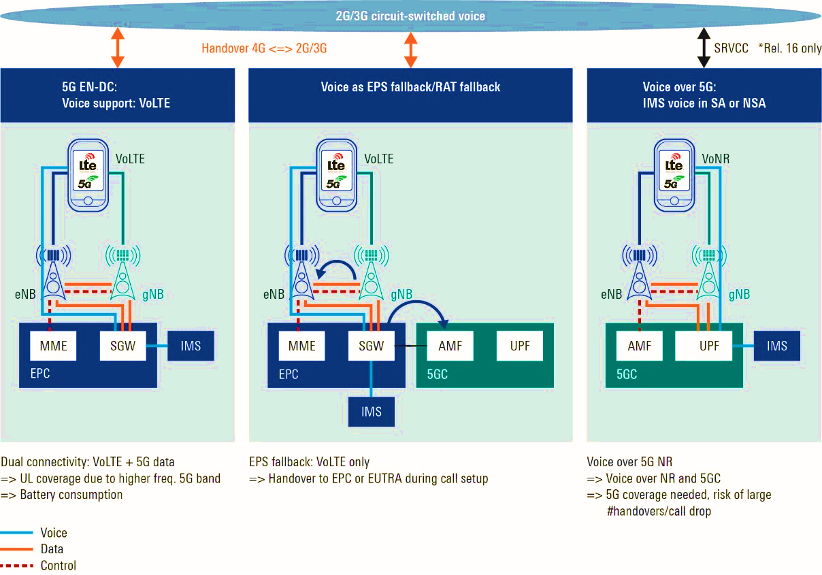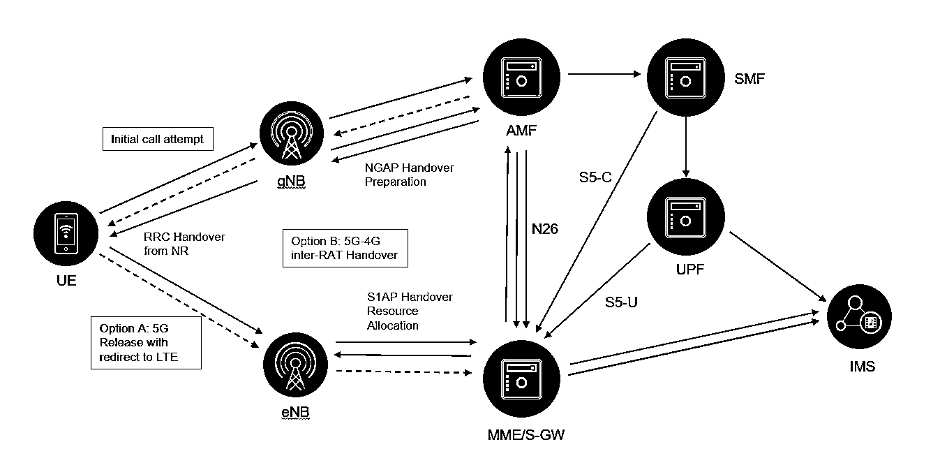Voice Communication Innovations in the 5G Era
5G technology promises blazing-fast data speeds and brings revolutionary enhancements to voice communication. In the realm of 5G, Voice over LTE (VoLTE) serves as a cornerstone, enabling high-quality voice calls over LTE networks. However, as the transition to standalone 5G advances, the landscape for voice options expands, introducing innovative ways to manage voice traffic. Handling […]
5G technology promises blazing-fast data speeds and brings revolutionary enhancements to voice communication. In the realm of 5G, Voice over LTE (VoLTE) serves as a cornerstone, enabling high-quality voice calls over LTE networks.
However, as the transition to standalone 5G advances, the landscape for voice options expands, introducing innovative ways to manage voice traffic.
Handling Voice in 5G NSA deployment
In the initial stages of deploying 5G, Non-Standalone (NSA) architecture integrates 5G technology with existing LTE infrastructure. NSA 5G relies on VoLTE for voice services as the primary option, ensuring a smooth transition from 4G to 5G. This configuration maintains voice continuity and quality, utilizing the robustness of VoLTE even in the early phases of 5G deployment.
If VoLTE (Voice over LTE) is unavailable, especially in areas with limited or absent LTE coverage or for other reasons, the network activates traditional circuit-switched fallback mechanisms. In the absence of VoLTE, the network reverts to legacy 2G or 3G technologies for voice calls, resulting in a negative impact on data services and degradation in voice quality.
As 5G deployment advances, network coverage and support for VoLTE are anticipated to increase. This growth aims to minimize situations where VoLTE is unavailable, ultimately improving the quality and reliability of voice calls.
In essence, VoLTE provides superior voice quality and supports simultaneous voice and data sessions over LTE & 5G NSA. However, the absence of VoLTE support prompts a fallback to older 2G/3G networks for voice calls, ensuring continuous voice communication but potentially compromising quality and data performance. As telecom infrastructure evolves, prioritizing the expansion of VoLTE coverage remains crucial to delivering enhanced voice services across broader areas.

Handling Voice in 5G SA deployment
As the industry transitions to Standalone (SA) 5G networks, Voice over New Radio (VoNR) emerges as the dedicated voice solution for standalone architecture. VoNR, a significant evolution from VoLTE, is optimized specifically for 5G networks, offering superior voice quality, lower latency, and enhanced support for new features enabled by 5G technology.
The transition from VoLTE to VoNR in SA 5G networks will occur gradually, allowing for a coexistence period where both technologies jointly handle voice services. This hybrid approach ensures backward compatibility and smooth migration, maintaining the integrity of voice services while capitalizing on the enhanced capabilities of VoNR.
In cases where 5G coverage is lacking or weak, alternative solutions may be needed to handle voice services despite the presence of VoNR.
To prevent bad call quality or call drops, especially for UEs making Voice over New Radio (VoNR) calls from the 5G cell edge, the UE is directed during the voice call setup towards the 5G core network (5GC). This forces a switch to an LTE/EPS connection where the radio conditions are better for the voice service, a procedure known as “EPS Fallback,” defined by 3GPP. This process also occurs when the UE is served by a 5G cell not configured or optimized for VoNR calls or when the UE lacks necessary VoNR capabilities.
Actually, we have 2 options to implement EPS fallback could be described as below
- In 5G release with redirection to LTE (Option A), the 5G radio connection is released after setup and redirected to LTE. Following the 5G RRC Release, the UE is instructed to reselect a 4G cell, initiating a new radio connection for the VoLTE call. During this process, the UE context is transferred from the AMF to the MME over the N26 interface.
- In 5G-4G Inter-RAT Handover (Option B), signaling and traffic are tunneled between SMF/UPF and MME/SGW.

SRVCC (Single Radio Voice Connection Continuity) is a feature in mobile networks ensuring seamless transitions between different technologies during voice calls, facilitating handover from LTE (4G) or NR (5G) to legacy 2G or 3G networks when moving out of coverage.
Both VoLTE and VoNR require an IMS system. Establishing a solid, robust, and well-tested IMS network is a challenging task, demanding considerable effort and continuous improvement.
For more information about Digis Squared VoLTE and IMS Services please check out the Managed Services page.
